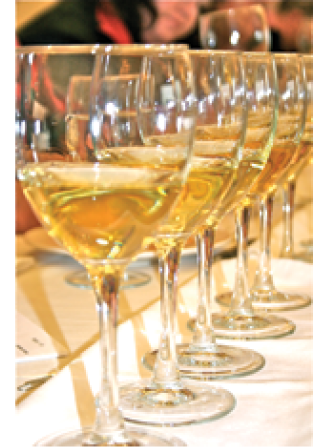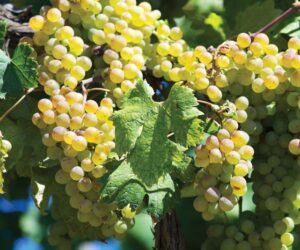 There’s a lot to be said for taking both similarities and differences in stride and appreciating both.
There’s a lot to be said for taking both similarities and differences in stride and appreciating both.
This applies to kit winemakers in the pursuit of which wine to make next. Grape, juice, and fruit winemakers often only have access to fruit grown in their local area, or that which can be shipped short distances during harvest. Kits, unlike relatively fragile grapes (or juice, or fruit) are shelf-stable and not only can they be made from grapes grown in any region in the world, they can also be shipped right to your door, any time of year.
This means that there are an enormous number of choices available. At last count the major manufacturers offered in excess of 100 varietals from a variety of countries, regions and viticultural areas.
Right now the most popular whites in America are Chardonnay, Riesling, Sauvignon Blanc, Gewürztraminer, and Pinot Gris/Grigio. The most popular reds are Cabernet Sauvignon, Merlot, Pinot Noir, Zinfandel, and Syrah/Shiraz. It’s easy to understand why these varietals flourish — the grapes grow well in most vineyards, have good recognition with consumers, and make pretty agreeable wines.
But sometimes you need to branch out: Man (and woman, of course!) does not live by Pinot Grigio alone. But when you’re craving a little variety how do you know what to make? You can read reviews, or the product descriptions that come from the kit manufacturers, but they usually classify wines in a broad sense. Every description seems to read, “Aromas of white fruit, floral notes and a crisp finish,” or “Deep red fruit leads to rounded berry flavors and a smooth, lingering finish.”
That’s not really the kind of hardcore information that you need to make a purchase decision, so I’ve devised a handy guide to comparing wine styles. For ease of use, I’ve broken it out into six categories, corresponding to the most common styles of wine available from kits:
• Soft, easy whites
• Aromatic whites
• Bold, rich whites
• Soft, fruity reds
• Medium-dry reds
• Blockbuster reds
Within each of the categories I’ve added a short marketing-speak description that will help guide your choice. Without further ado:
Soft, easy whites: If you like Riesling or Gewürztraminer, you’ll like . . .
Most wines in this category are either slightly sweet, or emphasize fruit character and lushness over structure or crispness. That’s not to say that they can’t be zingy underneath the fruit or residual sugar, but their mission is more about fruit character and a certain “gulpability.”
Moscato/Muscat – Snappy fresh aromas of peach, apricot with tropical notes.
Traminer-Riesling – Two great grapes blended together. Zing from Riesling, lychee and stone fruit from Traminer.
Müller-Thurgau – Riesling’s down-to-earth cousin, low acid, perfumey fruit and easy drinking.
Sémillon – Rounded, ripe melon fruit and a rich mouthfeel leading to a soft, low-acid finish.
Chenin Blanc – While it’s occasionally made into a big, dry white wine, most kit Chenins are lush with fruit, including quince, soft apple, and fresh pear, along with notes of honey.
Aromatic whites: If you like Sauvignon Blanc or Pinot Grigio, you’ll like . . .
Wines like these are mostly dry, and feature lively, full aromas with a bit more structure than the sweet ones. This isn’t to say they can’t display lush fruit: They’re just more about the aroma and a crisp finish.
Chamblaise – Code word for “California-style faux-Chablis,” this is usually a blend of French Colombard, Chenin Blanc, and a bit of Thompson. Crisp, with a refreshing finish and a hint of fruit.
Pinot Blanc/Pinot Bianco – White-berried mutation of Pinot Noir, this is medium bodied, with apple, citrus and floral notes, usually with a dry finish.
Viognier – A bit tricky, as this wine can be finished sweet as well, but usually it’s made to a style that emphasizes peach, apricot, dried pineapple, and spice.
Verdicchio – Light and crisp, with herbal notes of pear and a lemony finish.
Bold, rich whites: If you like Chardonnay, you’ll like . . .
High in alcohol and with any residual sweetness or fruit balanced by bracing acidity or intense oak, wines in this style are often drink-alone blockbusters rather than food pairing beverages.
Other Chardonnays – Chardonnay is the most popular white varietal going. Kit manufacturers source grapes from all over the world and match the prevailing styles of easily identifiable countries. Australian versions are aromatically fruity with wallops of sweet oak, French styles are drier, with more structure and medium notes of dark toasted oak, while specialty varieties may be made without oak at all to reveal the naked fruit.
Proprietary Whites – With names like Luna Bianca or Bella Bianco, these wines are an interpretation of the excessive “Big Chardonnay” with huge oak, high alcohol and dense structure. They can also have some residual sugar, but the oak knocks it into its place, preventing any real sweetness.
Viognier – Some interpretations of this style go for oaking and big flavor, similar to a blockbuster Chardonnay, but tuned up aromatically with strong stone fruit notes.
Soft fruity reds: If you like Pinot Noir, you’ll like . . .
Lower in alcohol, and made with varietals that have more delicacy and softness than roguish fruit or crushing tannin, most of these drink well young and even slightly chilled.
Other Pinot Noir – As mentioned, Pinot Noir can come from a wide array of growing areas. Kits without a declared AVA will generally verge on the light and simple, but French styles will be more angular and tannic, Chilean will display much more intense cherry/raspberry fruit, Oregon will split the difference between those two and California AVA kits will often have fruit character nearly as intense as Merlot.
Grenache – A sleeper grape, it has straightforward dark cherry notes, but the best examples have a hint of anise/black licorice in the finish, making them juicy and drinkable.
Sangiovese – Like many Italian varietals, it shows structure and tannin more strongly than fruit, with plum, red cherry and blackberry notes and a very firm finish.
Valpola/Valpolicella – Shows a pretty, ruby-red color, with aromas of tart cherry, berry, and spice.
Vieux Château du Roi/Castel del Papa – A proprietary name for wine kits made in the style of Châteauneuf-du-Pape, this is another tricky one: In the lower price points it’s cheerful and well-balanced between Grenache and Syrah grapes, with low to moderate oak. In the larger format, more expensive kits, it can become a very bold, assertive wine. However, it’s usually so well balanced and easy drinking that it comes off less as a blockbuster and more of a block-charmer.
Medium-dry reds: If You Like Merlot and Zinfandel, you’ll like . . .
Lush fruit, robust tannins and more pronounced structure in the finish makes these wines both more sophisticated and more versatile with food.
Carmenère – Merlot’s big brother, the one that’s been lifting weights and eating lots of protein, this wine is deep crimson with dark cherry and notes of chocolate and tobacco. Medium-bodied with moderate tannin, it still seems to punch above its weight.
Nero d’Avola – Seriously underrated, this wine has great texture, with ripe black cherry and herbs, and a finish with hints of blackcurrant.
Pinotage – A cross between Pinot Noir and Cinsaut, this wine can have smoky notes, brambleberry fruit (sometimes with notes of banana!) it can also come off as rustic and earthy.
Rioja Style – A traditional blend, this is a very “French” style from Spain, with bright cherry, firm tannin, and straightforward fruit.
Tempranillo – Spain’s version of Cabernet Sauvignon, but without the bruising tannins. Berry and plum line up with hints of tobacco and coffee in this medium-bodied but long-ageing wine.
Blockbuster reds: If you like Cabernet and Syrah, you’ll like . . .
Big is the watchword in this category: Big color, big fruit, big tannin, big oak, big alcohol, and big structure. These wines are the equivalent of strength athletes, rugby or football players, ready to tackle your palate and crush it. They are always memorable and intense.
Amarone Style – Based on the Corvina grape, this is a cracking big wine with 14%+ alcohol and classic Italian dry cherry, earth, leather, licorice, cassis, and coffee. Tannins stand out and teeth are stained. No cellar can be happy without at least one batch of this brooding in the corner.
Brunello Style – A kind of superheavyweight Sangiovese, this red belies its ripe cherry and currant notes with not only spice, pepper and leathery character, but also a firm acidity that combines with a brightly tannic finish to make it a great food wine.
GSM – Blending Grenache, Syrah and Mourvèdre, this is a new-world take on Rhône blends. Plummy black fruit with hints of anise, coffee, and tobacco, and notes of blueberry with strong but not astringent tannins.
Malbec – Black cherry, blackberry, blackcurrant and spicy notes make this grape rich, and big tannins give it length, power, and structure.
Montepulciano Style – Medium-bodied, the tannins combined with strong acidity are what moves this wine into the big category, along with dark fruit and spicy notes.
Nebbiolo – Another crushingly big Italian grape, the same one that goes into Barolo, this is not for the faint of palate: Dark cherry, black licorice, tar, and violets lead to a finish you almost need to chew.
Petit Verdot – A kind of “monster cabernet,” this Bordeaux grape is ultra fruit-forward with blackberry, blackcurrant and an intense, gripping finish.
Rossa/Rosso/Rojo – Proprietary styles of each of the kit manufacturers, these wines are a modern version of Amarone, but with warmer flavors, even more alcohol, and (frankly) ludicrous levels of sweet, toasty oak. Drinking a bit more like slightly dry red Port than table wine, they’re nevertheless tasty and rich.
Super Tuscan – Blending Cabernet or Merlot with Sangiovese yields a wine with the considered acidity and firm tannins of Italy and the straight-shooting fruit and big tannin of Bordeaux. Together they make a light-heavyweight of a wine, that has light feet and still manages a solid punch.
This list isn’t complete: Kit manufacturers change both varietals and styles all the time. It’s a good idea to compare this list to the product information guides for each kit, but as a general rule of thumb if you like one wine on the list, you’ll probably like them all.
Come to think of it, why not just like them all?






